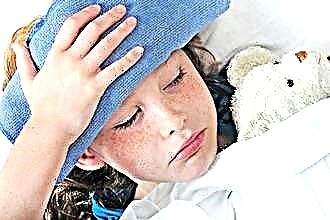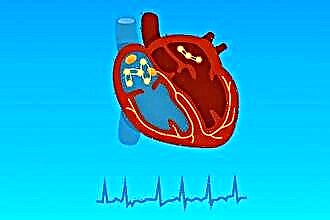 Now let's take a closer look at why croup develops, and what clinical manifestations make it possible to suspect pathology at the initial stage. Otolaryngologists often call the disease stenosing laryngitis, because the development is based on the inflammatory process. If you try to heal yourself for a long time, the lesion covers the trachea and bronchi.
Now let's take a closer look at why croup develops, and what clinical manifestations make it possible to suspect pathology at the initial stage. Otolaryngologists often call the disease stenosing laryngitis, because the development is based on the inflammatory process. If you try to heal yourself for a long time, the lesion covers the trachea and bronchi.
Note that croup can be both true and false. The differences lie in the reason: in the first case - suffocation develops when the child is sick with diphtheria, in the other - with inflammatory pathology of the larynx.
Most of the diseases that are accompanied by croup occur at the age of 1-6 years.
Children suffer from croup quite often. They have:
- the fiber is looser, so it becomes swollen faster;
- the special arrangement of nerve endings and their quick reaction predispose to reflex spasm of the larynx;
- the small diameter of the larynx contributes to the closure of the airways and the development of suffocation.
What happens in the larynx with croup? First, let's look at how the inflammatory response manifests itself. After the body is infected with an infection, the released toxin has a destructive effect on tissues and changes the permeability of the blood wall. As a result, we have edema, spasm and the presence of thick secretions. In the case of diphtheria, the lumen of the films is additionally narrowed, which is rather difficult to remove from the surface of the mucous membrane.
The listed changes are mostly observed in the area of the vocal cords, because this is the narrowest place. As a result, a vicious circle is observed: narrowing of the airways - insufficient oxygen supply to the brain - shortness of breath and paradoxical breathing, up to asphyxia - and again hypoxia, which ends with cerebral edema and death.
In order to help the child on time, you need to make the correct diagnosis at the initial stage. The tactics of treatment and the chances of recovery will depend on this. With diphtheria, deterioration occurs gradually, passing from stage to stage. Parents have time to consult a doctor and hospitalize their child.
But in the case of a false croup, suffocation can occur suddenly due to a reflex spasm of the larynx, which does not give time to think.
Why does croup develop?
The appearance of croup can be observed when children are infected with bacteria or viruses. It is very rare to find a fungal infection of the larynx with the development of suffocation. As already discussed, true croup is a consequence of diphtheria, false croup is a complication:
- inflammatory diseases (laryngotracheitis) with influenza or measles;
- the progression of bacterial (streptococcus, streptococcus, haemophilus influenzae) diseases.
It is quite rare to hear about croup due to the defeat of the respiratory tract by mycoplasmas, with syphilis or tuberculosis. The predisposing factors include weakened immunity, diathesis, rickets, embryonic hypoxia and congenital defects.
Croup classification and symptoms
When croup is suspected, symptoms and laboratory diagnostics should help establish the type of pathology (true or false). In the course of research, it is also determined which pathogen caused the deterioration of the condition.
So, how is true croup classified? It gradually goes through 3 stages, which gradually replace each other:
- catarrhal or otherwise - dysphonic. At this stage, you can see that the temperature slowly begins to rise, reaching 38 degrees. This indicates an increase in intoxication. The child becomes lethargic, moody, drowsy and has decreased appetite. The cough becomes a barking character, and the voice becomes hoarse. This condition lasts up to 3 days;
- stenotic. Breathing becomes heavy, noisy, when inhaling, the intercostal muscles are drawn in and it lengthens. The voice at this stage may already become silent, but sometimes hoarseness is still heard. The cough also becomes aphonic, which is associated with partial immobilization of the vocal cords. This stage lasts about 2 days,
 until there is anxiety of the child, increased sweating, blue lips, nose, ears and fingers.
until there is anxiety of the child, increased sweating, blue lips, nose, ears and fingers. - Asphyxia - characterized by rapid, shallow, irregular breathing, which gradually becomes less noisy. The skin becomes gray, consciousness is depressed, the limbs become colder, which is associated with impaired blood circulation. The condition deteriorates rapidly: the pulse is fast but weak, the pupils dilate, the pressure decreases, and seizures are also possible.
With a true croup, assistance can only be provided in a medical institution, where an anti-diphtheria serum is injected and a tracheostomy is performed.
As for the false croup, it can develop throughout the entire course of an infectious and inflammatory disease, but the greatest risk is noted in the first 3 days. Croup classification takes into account the degree of stenosis (narrowing) of the larynx.
| Degree | State | The state of the nervous system | Leather | Voice, cough, breathing | Heart rate |
|---|---|---|---|---|---|
| 1-compensation | Moderate severity | Anxiety | Regular color | Barking cough, hoarse voice, inhalation lengthened | Frequency is 5-10% higher than normal, good filling |
| 2-subcompensation | Heavy | Strong arousal | Pale skin, blue nose, ears, fingers, and lips | Rough, barking cough, noisy breathing, inhalation is lengthened, hoarseness | Increase in heart rate by 10-15% |
| 3-decompensation | Very heavy | Excitement is replaced by confusion, stupor | Earthy skin color, cyanosis, cold sweat | Less noisy breathing, inhalation is lengthened, exhalation is vice versa | Increase by 15-20%, poorly palpable, sometimes arrhythmia is recorded, deaf heart sounds |
| 4-asphyxia | Terminal | Consciousness is absent, convulsions | Widespread cyanosis of the skin | Breathing is shallow, irregular | Decreased heart rate, arrhythmia, cardiac arrest |
In addition to asphyxia, complications of croup include the risk of developing pneumonia, bronchial asthma, otitis media, sinusitis, meningitis, recurrence of asthma attacks and the appearance of bronchial asthma.
Diagnostic examinations
Treatment of croup in children begins after the cause is established. However, regardless of this, the symptoms at the initial stage are similar. At the reception, the patient talks about the nature of the cough, shortness of breath, fever, hoarseness, and general malaise.
Parents notice a change in the child's cough and voice. Noisy breathing occurs due to the narrowing of the larynx, through which air passes with difficulty. If you hear bubbling breathing, then there is a lot of mucus in the bronchi.
Note that with diphtheria, hyperthermia increases sharply and the general condition worsens literally in hours.
Depending on the prevailing symptoms, a pediatrician, an infectious disease specialist or an otolaryngologist can diagnose the disease. If complications from the lungs develop, additional consultation with a pulmonologist is necessary. You may also need to consult a phthisiatrician and a venereologist.
After the initial examination, the doctor performs a laryngoscopy, in which he detects films, edematous mucosa, assesses the extent of the lesion, as well as the narrowing of the larynx. When listening to the lungs, wheezing of a different nature is found.
To confirm his suspicions, the doctor directs the patient for laboratory diagnostics, the material for which is collected from the surface of the mucous membrane of the pharynx. Research is carried out by microscopy and bacteriological analysis. You can also test blood by PCR and ELISA. A separate examination is carried out for syphilis and tuberculosis. To identify complications, pharyngo-, oto-, rhinoscopy, X-ray examinations and analysis of cerebrospinal fluid are performed.
In the differential diagnosis process, croup symptoms must be distinguished from whooping cough, airway foreign matter, asthma, retropharyngeal abscess, and congenital stridor.
First aid
When a child is sick, the parents are even worse, because they do not sleep, they are worried and the child's life depends on them. To calm down a little, you need to consult a doctor and start treatment immediately.
If the child's condition has worsened for the first time, you need to call an ambulance and try to alleviate his condition as much as possible:
- you need to be close to the child, distract him, stroke him, that is, try to calm him down and stop crying;
- drinking plenty of alkaline still water or warm milk. This will calm the baby and make the phlegm thinner, which makes it easier to pass and breathe;
- oxygen access. It is necessary to ensure the supply of fresh air, so we open the windows (but not a draft!);
- in case of fever, it is necessary to reduce the temperature to normal. For this, antipyretic drugs are used that do not contain aspirin. For example, you can give Nurofen, Panadol or Efferalgan suppositories;
- to reduce tissue swelling, antihistamines such as Suprastin, Loratadin or Claritin are indicated;
- if the child has difficulty breathing through the nose due to swelling of the nasal mucosa and mucous discharge, vasoconstrictor nasal drops should be dripped in order to restore nasal breathing;
- alkaline inhalations are especially useful with mineral water or soda solution. It will be great if there is Pulmicort in the house (this is a hormonal drug that is used for inhalation and does not have a systemic effect).
If you do not have an inhaler, remember how you used to do steam inhalation from improvised means. You need to take a bath of hot water and fill up a pack of soda. After that, the child will be in the bathroom and inhale alkaline vapors. To distract him, you can transfer toys or colored books to him. Parents should not lose their composure, because panic will only exacerbate the situation.
Some parents are so effective in coping with croup and are able to detect it in a timely manner that in most cases they do not call an ambulance. At the first symptoms, they begin treatment and thereby prevent further deterioration of the condition.
When a child often has seizures, parents are ready for this and have at home the hormonal solution Benacort, Pulmicort, antihistamines and a nebulizer. It is better to have a compressor device, because ultrasonic is not suitable.
If a child develops an attack of suffocation, parents need to understand that within the next two days, the risk of further deterioration is extremely high. In this regard, they need to sleep near the child at night in order to provide help on time.
For cereals, it is forbidden to use herbal decoctions, oil products for inhalation or ingestion, and also use throat sprays.
Inpatient treatment
 When croup is diagnosed, treatment should be carried out in a hospital, because the deterioration of the condition can be at any moment, and no one can help the child at home. The treatment uses:
When croup is diagnosed, treatment should be carried out in a hospital, because the deterioration of the condition can be at any moment, and no one can help the child at home. The treatment uses:
- hormonal agents, such as Prednisolone, which are administered intramuscularly. Do not be afraid of hormones, they are prescribed in a short course; antihistamines (Suprastin, Zodak, Diazolin);
- mucolytics and expectorants (Lazolvan);
- inhalation with mucolytics, alkaline water or hormones;
- restorative therapy (vitamins);
- detoxification therapy;
- sedatives;
- antibacterial (Amoxiclav, Zinnat) or antiviral (Nazoferon) therapy.
If there are signs of hypoxia, oxygen therapy is performed. When there is a threat of asphyxia, a tracheostomy is urgently performed.
Prophylaxis
It is impossible to completely protect the child from infection, but you can work on strengthening the immune defense. To do this, you should:
- normalize nutrition, enrich with vitamins;
- enough time to be outdoors;
- ventilate the room, do wet cleaning;
- hardening;
- you need good rest and healthy sleep;
- timely treatment of inflammation of the oropharynx and nasopharynx;
- visiting the dentist twice a year;
- humidifying the air in the room;
- no need to expose the child to heavy sports, swimming and cycling are useful;
- do not contact people with an infection, especially during an epidemic;
- lack of contact with allergens.
Spa treatment is especially important for children. Sunbathing, sea air and water procedures will strengthen the immune system and restore the psycho-emotional state. Do not underestimate the role of vaccination against diphtheria, because vaccination has been saving the lives of millions of people for 40 years.
If, upon the arrival of the ambulance team, the doctor offers hospitalization, do not try to refuse, because another time the child may not have time to be helped.

 until there is anxiety of the child, increased sweating, blue lips, nose, ears and fingers.
until there is anxiety of the child, increased sweating, blue lips, nose, ears and fingers.

